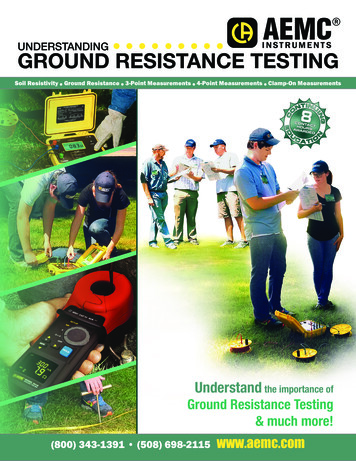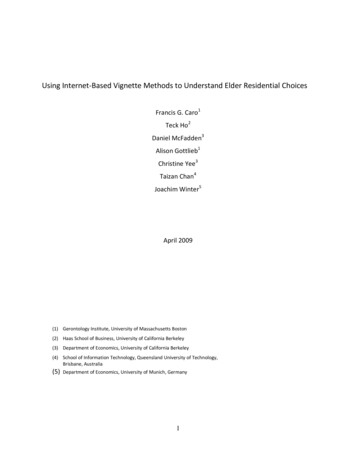
Transcription
Soil Resistivity Ground Resistance 3-Point Measurements 4-Point Measurements Clamp-On MeasurementsUnderstand the importance ofGround Resistance Testing& much more!(800) 343-1391 (508) 698-2115www.aemc.com
A One Day Training SeminarIn today’s rapidly changing world of t echnological advances, good grounding is more importantthan ever to prevent costly damage and downtime due to service i nterruptions and inoperativesurge p rotection caused by poor grounds. Grounding s ystems offer protection from n aturalphenomenon such as lightning by channeling the lightning c urrent to the ground, protectingpersonnel from injury and protecting system c omponents from damage. In electric powersystems with ground returns, grounds help ensure rapid operation of the p rotection relays byproviding low resistance fault paths in the event of unexpected potentials due to faults.Low ground resistance is required to meet NEC , OSHA and some warranty requirements plus other electrical safety s tandards.Electrode DesignationsVarious manufactures have employed different designations for the electrodes used in Fall of Potentialground resistance testing. The most common in use were:IndustryInjector Electrode: H, Z or C2Potential Electrode: S, Y or PGround under Test: E, X C1The Industry has adopted standardized designations in use since the early 2000s They are:InternationalInjector Electrode: HPotential Electrode: SGround under Test: EThis workbook uses the international H, S and E electrode designations. 2021 Chauvin Arnoux , Inc. d.b.a. AEMC Instruments i www.aemc.com Technical Assistance (800) 343-1391
ContentsSoil Resistivity1Soil Resistivity Measurements34-Point MeasurementGround Electrodes5Ground Resistance Testing Principle8Fall-of-Potential – 3-Point MeasurementMultiple Electrode Systems12Tech Tips13Clamp-On Ground Resistance Measurement16(Models 6416 & 6417*)Telecommunications19Ground Nomograph22Fall-of-Potential Plot23 Models 6416 & 6417 have replaced Models 3711 & 3731ReferencesIEEE Std 81-2012— EEE Guide for Measuring Earth Resistivity, Ground Impedance, and Earth Surface Potentialsof Ground SystemsIEEE Std 142-2007— IEEE Recommended Practice for Grounding of Industrial and Commercial Power Systems2014 NECTechnical Assistance (800) 343-1391 www.aemc.com ii
Soil ResistivitySoil ResistivityWhy Measure Soil Resistivity?Soil resistivity measurements have a threefold purpose.First, data is used to make sub-surface geophysical surveys as anaid in identifying ore locations, depth to bedrock and other geologicalphenomena. Second, r esistivity has a direct impact on the degreeof corrosion in underground pipelines. A decrease in resistivity relatesto an increase in corrosion activity and therefore dictates the protectivetreatment to be used. Third, soil r esistivity directly affects the design ofa grounding system, and it is to that task that this discussion is directed.When designing an extensive grounding s ystem, it is advisable to locatethe area of lowest soil resistivity in order to achieve the most economicalgrounding installation. Note: The lower the soil resistivity value, the lower the groundingelectrode resistance will be.Effects of Soil Resistivityon Grounding Electrode ResistanceSoil resistivity is the key factor that determines what the resistance of agrounding electrode system will be, and to what depth it must be drivento obtain low ground resistance. The resistivity of the soil varies widelythroughout the world and changes seasonally. Soil resistivity is determinedlargely by its content of electrolytes, which consist of moisture, mineralsand dissolved salts. A dry soil has high resistivity if it contains no soluble salts.SoilResistivity (approx.), Ω-cmMinAverageMaxAshes, cinders, brine, waste59023707000Clay, shale, gumbo, loam340406016,300Same, with varying proportionsof sand and gravel102015,800135,000Gravel, sand, stones with littleclay or loam59,00094,000458,000Figure 1Factors Affecting Soil ResistivitynotesTwo samples of soil, when thoroughly dried, may in fact become very goodinsulators having a resistivity in excess of 109Ω-cm. The r esistivity of thesoil sample is seen to change quite rapidly until a pproximately 20% orgreater moisture content is reached. (Figure 2)1Resistivity Ω-cmMoisture content% by weightTop SoilSandy Loam0 109 19,00010,500203012,000640063004200 www.aemc.com Technical Assistance (800) 343-1391Figure 2
TemperatureResistivity Ω-cm C F206872001050990013,800032 (water)032 (ice)30,000-5-15231479,000330,000Soil ResistivityThe resistivity of the soil is also influenced by temperature. Figure 3 showsthe variation of the resistivity of sandy loam, containing 15.2% moisture,with temperature changes from 20 to -15 C. In this temperature range theresistivity is seen to vary from 7200 to 330,000Ω-cm.Figure 3Because soil resistivity directly relates to moisture content and temperature,it is reasonable to assume that the resistance of any grounding system willvary throughout the different seasons of the year. Such variations areshown in Figure 4. Since both temperature and moisture content becomemore stable at greater distances below the surface of the earth, it followsthat a grounding system, to be most effective at all times, should beconstructed with the ground rod driven down a considerable distancebelow the surface of the earth. Best results are obtained if the ground rodreaches the water table.OhmsFigure 4Seasonal variation of earth resistance with an electrode of/4" pipe in rather stony clay soil. Depth of electrode in earth is3 ft for Curve 1, and 10 ft for Curve 23Chemically treated soil is also subject to considerable variation ofresistivity with temperature changes, as shown in Figure 6. If salttreatment is employed, it is necessary to use ground rods which willresist chemical corrosion.notesIn some locations, the resistivity of the earth is so high that low-resistancegrounding can be obtained only at considerable expense and with anelaborate grounding system. In such situations, it may be economical touse a ground rod system of limited size and to reduce the ground resistivityby periodically increasing the soluble chemical c ontent of the soil.Figure 5 shows the s ubstantial reduction in resistivity of sandy loambrought about by an increase in chemical salt content.Technical Assistance (800) 343-1391 www.aemc.com 2
THE EFFECT OF SALT* CONTENT ON THE RESISTIVITY OF SOILSoil ResistivityMeasurements(Sandy loam, Moisture content, 15% by weight, Temperature 17 C)Added Salt(% by weight of moisture)Resistivity (Ω-cm)010,7000.118001.046051901020130100Figure 5THE EFFECT OF TEMPERATURE ON THE RESISTIVITYOF SOIL CONTAINING SALT*(Sandy loam, 20% moisture. Salt 5% of weight of moisture)Temperature (Degrees C)Resistivity (Ω-cm)20110101420190-5-133121440*Such as copper sulfate, sodium carbonate, and others.Salts must be EPA or local ordinance approved prior to use.Figure 6Soil Resistivity Measurements4-Point MeasurementnotesR3esistivity measurements are of two types; the 2-Point and the4-Point method. The 2-Point method is simply the resistancemeasured between two points. For most applications the mostaccurate is the 4-Point method which is used in Ground TesterModel 4620, 4630, 6470-B, 6471 or 6472. The 4-Point method (Figures 7and 8), as the name implies, requires the i nsertion of four equally spacedand in-line electrodes into the test area. A known current from a constantcurrent generator is passed between the outer electrodes. The potentialdrop (a function of the resistance) is then measured across the two innerelectrodes. The Model 4620, 4630, 6470-B, 6471 and 6472 are calibratedto read directly in ohms. Where space or access to inserting rods is aproblem, the Miller box and multiple depth testing may be used. TheSchlumberger method is used mainly for geologic surveys.NOTE:To use feet instead of cm: 2π x (conversion from cm to ft) (2) (3.14) [(12) (2.54) 191.5] www.aemc.com Technical Assistance (800) 343-1391
Where:ρΕ measured apparent soil resistivity (Ωm)Rw Wenner resistance measured as “V/I” inFigure (Ω) If b is small compared to a, as is the case of probespenetrating the ground only for a short distance (as normallyhappens), the previous equation can be reduced to:ρΕ 2 π a RwThe value to be used for ρ is the average resistivity of the ground at a depthequivalent to the distance “A” between two electrodes for all tests taken.Soil ResistivityMeasurementsa electrode spacing (m)b depth of the electrodes (m)Given a sizable tract of land in which to determine the optimum soil resistivity, some intuition is in order. Assuming that the objective is low resistivity, preference should be given to an area containing moist loamas opposed to a dry sandy area. Consideration must also be given to thedepth at which resistivity is required. ρ (Ω-cm) 2π AR x 100 (with A in m) ExampleAfter inspection, the area investigated has been narrowed down to a plotof ground approximately 75 square feet (7m2). Assume that you need to determine the resistivity at a depth of 15 ft (450cm). The distance “A”between the electrodes must then be equivalent to the depth at which average resistivity is to be determined (15 ft, or 450cm). Using the more simplified Wenner formula (ρ 2π AR), the electrode depth must then beno more than 1/20th of the electrode spacing or 87/8" (22.5cm).AAAAAORAHSAEvAFigure 7AEAAABRAAAFigure 8For example, if the reading is R 15 ρ (resistivity) 2π x A x RA (distance between electrodes) 450cmρ 6.28 x 15 x 450 42,390Ω-cmnotesLay out the electrodes in a grid pattern and connect to the instrumentas shown in Figure 8. Proceed as follows: Remove the shorting link between E and Es (C1, P1) Connect all four auxiliary rods (Figure 7)Technical Assistance (800) 343-1391 www.aemc.com 4
GroundingElectrodesGrounding ElectrodesThe term “ground” is defined as a conducting connection by whicha circuit or equipment is connected to the earth. The connection isused to establish and maintain as closely as possible the potentialof the earth on the circuit or equipment connected to it. A “ground”consists of a grounding conductor, a bonding connector, its groundingelectrode(s), and the soil in contact with the electrode.“Grounds” have several protection applications. For natural phenomena suchas lightning, grounds are used to discharge the system of current beforepersonnel can be injured or system components damaged. For foreignpotentials due to faults in electric power systems with ground returns,grounds help ensure rapid operation of the protection relays by providinglow resistance fault current paths. This provides for the removal of theforeign potential as quickly as possible. The ground should drain the foreign potential before personnel are injured and the power or communicationssystem is damaged.Ideally, to maintain a reference potential for instrument safety, protectagainst static electricity, and limit the system to frame voltage for operatorsafety, a ground resistance should be zero ohms. In reality, as we describefurther in the text, this value cannot be obtained.Last but not least, low ground resistance is essential to meet NEC , OSHAand other electrical safety standards. Figure 9 illustrates a grounding rod. The resistance of the electrode hasthe following components:(A) The resistance of the metal and that of the connection to it.(B) The contact resistance of the surrounding earth to the electrode.(C) The resistance in the surrounding earth to current flow or earthresistivity which is often the most significant factor. More specificallynotes(A) Grounding electrodes are usually made of a very conductive metal(copper or copper clad) with adequate cross sections so that theoverall resistance is negligible.5(B) The National Institute of Standards and Technology has demonstratedthat the resistance between the electrode and the surrounding earth is negligible if the electrode is free of paint, grease, or other coating, andif the earth is firmly packed. www.aemc.com Technical Assistance (800) 343-1391
GroundingElectrodes(C) The only component remaining is the resistance of the surroundingearth. The electrode can be thought of as being s urrounded byconcentric shells of earth or soil, all of the same thickness. The closerthe shell to the electrode, the smaller its surface; hence, the greaterits resistance. The farther away the shells are from the electrode, thegreater the surface of the shell; hence, the lower the resistance.Eventually, adding shells at a distance from the grounding electrodewill no longer noticeably affect the overall earth resistancesurrounding the electrode. The distance at which this effect occurs isreferred to as the e ffective resistance area and is directly dependenton the depth of the grounding electrode.Ground rodand clampContactresistancebetween rodand soilConcentricshells ofearthFigure 9Effect of Grounding Electrode Sizeand Depth on ResistanceResistance in %Size: Increasing the diameter of the rod does not significantly reduce itsresistance. Doubling the diameter reduces resistance by less than 10%.(Figure 10)10075502501/25/83/411 1/41 1/21 3/4Figure 10notesRod diameter (inches)Technical Assistance (800) 343-1391 www.aemc.com 6
GroundingElectrodesDepth: As a ground rod is driven deeper into the earth, its resistance issubstantially reduced. In general, doubling the rod length reduces theresistance by an additional 40% (Figure 11). The NEC (2014, 250.53 G)requires a minimum of 8 ft. (2.4m) in contact with the soil.NEC (2014, 250.53 G) states that rod electrodes of stainless steel andcopper or zinc coated steel shall be at least 15.87mm (5/8 in) diameter,unless listed and not less than 12.70mm (1/2 in) in diameter.200100Resistance in ohms806040Ω @ 10 ft.24Ω @ 20 ft.4030201" dia.1/2" dia.1086543215152535 40506070Driven depth in feetGround
IEEE Std 81-2012 EEE Guide for Measuring Earth Resistivity, Ground Impedance, and Earth Surface Potentials of Ground Systems IEEE Std 142-2007 IEEE Recommended Practice for Grounding of Industrial and Commercial Power Systems 2014 NEC











